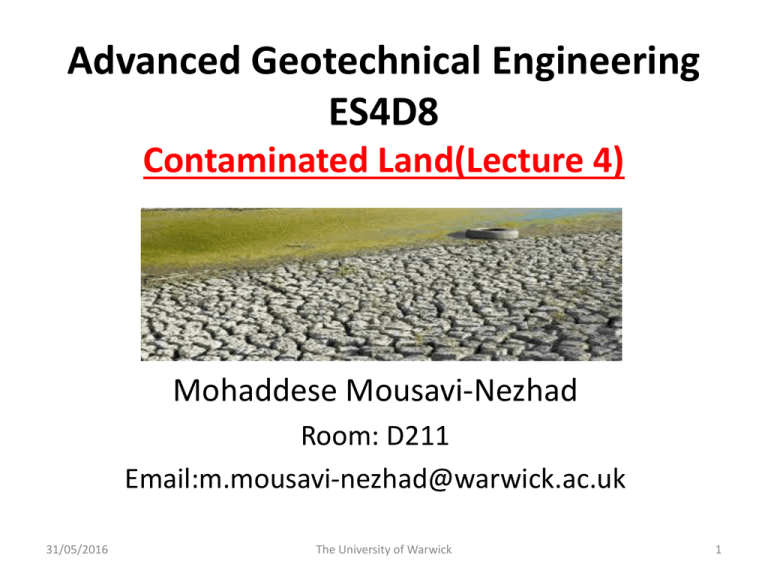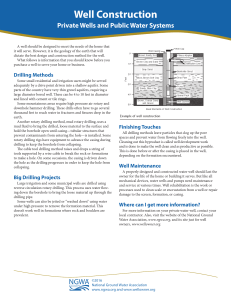Advanced Geotechnical Engineering ES4D8 Contaminated Land(Lecture 4) Mohaddese Mousavi-Nezhad
advertisement

Advanced Geotechnical Engineering ES4D8 Contaminated Land(Lecture 4) Mohaddese Mousavi-Nezhad Room: D211 Email:m.mousavi-nezhad@warwick.ac.uk 31/05/2016 The University of Warwick 1 Site Investigation Phase II investigation: consist of a site characterisation phase (phase IIa) and groundwater monitoring well installation (Phase IIb). • The extreme complexity and variability inherent to most soils necessitates that a multitude of investigation and monitoring approaches be incorporated into subsurface investigations. • Both field and laboratory tests are necessary to comprehend the presence and behaviour of polluted soils. • Field testing primarily provides information regarding soil characteristics, groundwater flow conditions, and pollutant migration. • Laboratory testing supplies data on the type and quantity of a pollutant present in the subsurface. Basics & Terminology A variety of investigative techniques are available for the collection of data for the characterization of sites. The actual site investigation will include direct and indirect methods. Direct methods for site investigation: • Boreholes • Piezometers • Geotechnical analysis of soil samples Indirect methods: • Aerial photography • Ground penetrating radar • Earth conductivity and resistivity geophysical studies. Basics & Terminology Geophysical Techniques • Ground Penetration Radar (GPR) • Electromagnetic conductivity (EM) • Electrical resistivity surveys • Seismic surveys Ground Penetration Radar (GPR) We measure • Two way travel time • Amplitude of the signal We identify the depth of the layer or objects underground. Ground Penetration Radar (GPR) Ground Penetration Radar (GPR) Ground Penetration Radar (GPR) Hyperbola Basics & Terminology Ground Penetration Radar (GPR) Ground Penetration Radar (GPR) 1 2 3 Ground Penetration Radar (GPR) • There are depth limits to this technique, with signal attenuation becoming more important at depths where subsurface materials have low electrical conductivities, i.e., where pore fluids are present in quantity. • Optimal conditions for this technique are sandy or rocky soils in unsaturated (vadose) zones or bedrock with low hydraulic conductivity where water is not permanently present. • Clay-rich sediment, which by their nature retain more water than most sediments, and other dump or saturated sediments will generally yield poor results. • However, reliable data are obtainable in settings where pore fluids have a low specific conductance, e.g., where significant amounts of petroleum products are present. Electromagnetic conductivity (EM) The system consists of a transmitter coil (TC), energized with an alternating current at an audio frequency, and a receiver coil (RC), located at a short distance away from the transmitter. • The transmitter coil (TC) creates a primary magnetic field (Hp) that induces currents in the subsurface. • These currents generate a secondary magnetic field Hs which is sensed, together with the primary field, Hp, by the receiver coil (RC). Electromagnetic conductivity (EM) • In general, this secondary magnetic field is a complicated function of the intercoil spacing, s, the operating frequency, f and the ground conductivity, σ. In a simplified form: Hs is secondary magnetic field at the receiver coil, Hp is primary magnetic field at the receiver coil, ω = 2πf, f is frequency, μ0 is permeability of free space, σa is ground conductivity, s is inter-coil spacing Electromagnetic conductivity (EM) Since the electromagnetic technique produces results in conductivity units, it can be of immediate use at the site to: • Determine the water quality: The recorded conductivity values provide an indication of the relative difference in dissolved ion contents, hence provide a measure of water quality, as shown in Table 2 (next slide). • Quantify the soil salinity: Salinity classes, based on electrical conductivity of a saturated extract, as defined by US EPA, are shown in Table 3 (next slide). • Determine the concentration of cations and heavy metals: This can be obtained with the use of the following relationships (Kayyal and Mohamed, 1997): (a) For cations: σ = 0.121249 + 0.003155xC 0.940930 (b) For heavy metals: σ = 0.004773 + 0.001894xC 0.941766 σ is electrical conductivity in mmho/cm, and C is the equilibrium concentration of the total heavy metals or cations in solution (ppm). Electromagnetic conductivity (EM) Table 2: Typical values of specific conductivities for various water types. Table 3: Salinity classes of soils. HYDROGEOLOGICAL INVESTIGATIONS Well installation procedure depends on: (1) the expected geology of the site, (1) type of liquid waste and its anticipated effect on the drilling mud and well materials (3) the effect of the installation procedures on the reliability of the water quality data. Appropriate drilling methods for sampling and installing wells should be selected. Number and depth of boreholes • Number of Boreholes – Depends on site conditions – Should enable the basic geological structure of the site to be determined – Typically one borehole for 200-400 m2 • Borehole Depth – Must include all strata that was affected by contaminants or have the potential to be affected 17 Drilling Methods Percussion (or Cable Tool) Drilling Auger Drilling – Hand Auger – Mechanical Augers Flight Augers Bucket Auger Hollow Stem Augers Rotary Drilling 18 Percussion Drilling (after Craig 2004) 19 Percussion Drilling (contd.) Perhaps the commonest technique Reasonably cheap Can reach to large depths Suitable in almost all soils The rig is versatile 20 Auger Drilling 21 Hand Augers • • • • Borehole diameter up to 200mm Depths of around 5m Very cheap Used in self-supporting strata without hard obstructions or gravel-sized particles • Auger must be withdrawn at frequent intervals for the removal of soil 22 Mechanical Augers (after Craig 2004) 23 Flight Augers • Typical diameters between 75 mm and 300mm • Borehole depths up to 30-50 m • Suitable for cohesive soils • Require considerable mechanical power and weight • Give only a very rough indication of the levels and character of the strata • Continuous-flight augers (b) more efficient than short-flight augers (a) 24 Flight Augers (contd.) Continuous flight auger drilling (http://www.machibroda.com) 25 Bucket Auger • Consists of a steel cylinder, open at the top but fitted with a base plate on which cutters are mounted • Typical diameters between 300 and 900mm • When the bucket is full it is raised to the surface to be emptied • Allows downhole logging 26 Bucket Auger (contd.) Hollow Stem Auger – Casing with outer spiral – Inner rod with plug/or pilot assembly – For sampling, remove pilot assembly and insert sampler – Typically 1.5m sections, keyed, box & pin connections – Maximum depth 30‐50m – Internal diameter 50‐300 mm Hollow Stem Auger • No drilling fluids are used and disturbance of the geologic materials penetrated is minimal. • In formation where the borehole will not stand open, the monitoring well can be constructed inside the hollow-stem auger prior to its removal from the hole. • The hollow stem auger has an added advantage in offering the ability to collect continuous in-situ geologic samples without removal of the auger sections. Hollow Stem Augers (contd.) Rotary Drilling • The fastest drilling method • Although primarily intended for investigation in rock, the method is also used in soils • Bit at the en of drill rod is rotated and advanced • Soil/rock cuttings removed by circulating drilling fluid (e.g. bentonite mud) • Typical core diameters of 41, 54, and 76 mm Sampling Sampling Process Type of Soil Samples 1) “Undisturbed” Sample – Minimizes effects from potential disturbance – Needed for determination of in-situ density, in-situ permeability, soil shear strength and compressibility 2) Disturbed Sample – No attempt to retain the in-situ structure of the soil – Suitable for classification and compaction tests Well Installation Techniques • After the test bore hole is drilled and the subsurface material is sampled, a monitoring well device can be installed in the bore hole for groundwater sampling and measuring piezometric levels. • Water samples can be taken to determine the water chemistry Drive Point Wells The most common techniques for monitoring well installations are: • Drive Point Wells • Individual Wells Well Installation Techniques The simplest and least expensive technique to install a monitoring well is to drive the well screen and casing down to the desired depth with a hammering device. • Drive point monitoring wells commonly range in diameter from 15 to 30 mm. • They have been successfully installed in soft soils up to 30 m. • The length of the screen commonly ranges between 0.2 and 1.0 m. Individual Wells • The most common type of monitoring well is the individual well installed in a drilled borehole. • These types of monitoring wells commonly range from 0.02 to 0.1 m in diameter. • They are typically constructed of steel, stainless steel, PVC, or Teflon, depending upon the requirements for chemical sampling. • The screen and filter pack should ensure that formation water can pass easily into the monitoring well. Individual Wells • The placement technique is as follow: (1) Place the selected well screen and casing down into the borehole to the required depth, (2) Install permeable filter pack material around and slightly above the well screen to allow groundwater from the adjacent formation to flow freely to the well screen, (3) Place a sealing material above the filter pack to isolate the well Screen from the rest of the borehole, (4) Backfill the annulus above the seal with a grouting material, (5) Install a protective cover over the well casing at ground level for Security and to prevent precipitation from entering the well.


